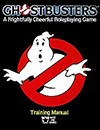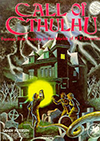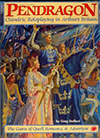100 Best Games - Ghostbusters
Just click on the game cover to read the related essay

Ghostbusters - James Wallis
Key Designers: Sandy Petersen, Lynn Willis, Greg Stafford, Greg Costikyan
West End Games (1986)
In the twentieth century it was a truism that games based on movie and TV licenses were almost universally bad. Though there were occasional exceptions — James Bond licenses in particular — the general standard was very low, and many players avoided them on principle. While the roleplaying field had fared a little better, the number of decent RPGs based on media properties was still small. And in the mid-1980s, not long after FASA had made a disappointing job of both Doctor Who and Star Trek, and TSR’s Indiana Jones and Conan had been slammed and cancelled in short order, nobody held much hope that West End’s Ghostbusters roleplaying game would be anything different.
But the game that emerged from behind that overfamiliar logo was accessible, innovative, exciting, genuinely funny, and had an impact on RPG design that’s still felt today. What’s more, it pushed ideas about appeal and accessibility which, had they been picked up by other companies and other designers, might have prevented the RPG industry’s slide into thirty years of obscurity.
Ghostbusters: A Frightfully Cheerful Roleplaying Game was created by a dream team of top-name designers. Though West End was the publisher, the design work was done by Chaosium staff — specifically Sandy Petersen (Call of Cthulhu), Greg Stafford (Pendragon, RuneQuest), and Lynn Willis (Godsfire) — and then edited by Greg Costikyan (Paranoia, Toon). It won the H.G. Wells Award for best RPG rules in 1986, directly inspired the mechanics of the Star Wars Roleplaying Game (1987) and West End’s d6 System, as well as many of the notable RPGs of the 1990s.
Ghostbusters was designed to be a pick-up-and-play RPG; a new GM (or “ghostmaster”) could begin running his first session of the game in minutes. This required a radically different approach to the whole area of RPG design, which in the 10 years since D&D had settled into something of a rut. Open the game’s box and you’re met by a two-page introduction to the rules, a two-page example of play (and if you’ve never heard me extol the importance of an example of play, then you’ve never got me properly drunk), a two-page guide to ghosts, and loads of Ghostbusters paperwork: franchise contracts, EPA permits, last wills and testaments, and the like.
There are also cards. On closer examination, half of these turn out to be pregenerated characters — the movie characters who you already know, since you’ve bought a game called Ghostbusters — and the other half represent equipment that a typical Ghostbuster might carry: proton packs, PKE meters, ghost traps, copies of Tobin’s Spirit Guide, a bullhorn (“allows user to make more noise than anyone else” but there are two of them), and a beach kit (“triples fun at beach”). So each player grabs a character card and three equipment cards, the GM reads the first adventure (“30th and Lexington,” four pages of pure introductory roleplaying goodness), and you are ready to go. Really, you are.
There’s more in the box: the 24-page Training Manual, which contains all the game’s rules, and the 64-page Operations Manual, which is mostly GM advice, adventures, and instructions on how to run a Ghostbusters franchise and a campaign. All of this is laid out in a friendly, accessible way, and decorated with movie stills, caricatures of the principal characters, pull-quotes, and jokes. It makes you feel that this roleplaying stuff is really quite simple. It might even be fun.
And it is fun. Humor is a notoriously difficult thing to capture in a roleplaying game, but Ghostbusters gets it right, both to read and to play. A large part of this is down to the game’s mechanics which are blisteringly simple, easy to grasp, and perfectly capture the anarchic atmosphere of the original movie. The game does not try to make the movie’s story conform to the real world or the needs of a conventional RPG system; instead, what rules there are fit to the atmosphere of a Ghostbusters story, and anything not necessary (hit points, weapons tables) is simply omitted.
A Ghostbusters character has four attributes (called “traits”): brains, muscle, moves, and cool, all rated between 1 and 7. This represents the number of dice that the player rolls against a difficulty number set by the ghostmaster for any given task. According to the rules picking up someone in a singles bar would be a difficulty 5 (easy) moves task, while eating a telephone would be difficulty 30 (impossible) on muscles. It was the ’80s: telephones were larger. This system is generally recognized as the first “dice pool” mechanic in a roleplaying game.
On top of this, each character has one “talent” per trait, a specialization of his or her own choice — and it’s often a wild choice, like “shoot .44 so that blood and guts splatters everywhere” or “grab heroine in untoward manner.” Talents give a bonus of three additional dice on a difficulty roll. Characters also have “brownie points,” a catch-all that encompasses stamina, luck, hero points, experience points, and whatever the GM needs them to be. Brownie points can be used to buy new points in traits, and players can also trade in a trait point to buy more brownie points in an emergency.
That’s pretty much it for mechanics, but Ghostbusters has one last brilliant trick up its sleeve: the ghost dice. This is a regular six-sider, except the 6 has been replaced by the Ghostbusters logo. The ghost dice must be rolled as one of the dice every time someone makes a trait check. If it comes up ghostly then Something Bad Has Happened, and the worse the roll, the worse the surprise.
All this works together to create an intensely playable and fast-paced game that’s spontaneous, exciting, and funny. The broad strokes used to draw the characters and the simplicity of the system keep things on the right side of serious, while never letting play lapse over the edge into slapstick or stupidity. The game can work equally well for one-off adventures or campaign play. In particular, it has an amazing power to remind GMs and players what’s great about roleplaying, to refresh the spirit and reinvigorate the palate with a blast of delightful fun.
Sadly, the printed adventures for the game never measured up to its original brilliance, despite a list of top-notch creators including John M. Ford, Dan Greenberg, Scott Haring, and an uncredited Allen Varney. Ghostbusters, International, released in 1989 to coincide with the second Ghostbusters movie, was not developed by any members of the original creative team and gave the system the one thing it didn’t need: more rules. West End’s Men In Black RPG (1997) tried to recapture the same magic. Despite some interesting ideas, it ended up as no more than a shadow of its inspiration.
Imagine if there had been more pick-up-and-play RPGs back when computer games were making their first serious incursion on to RPGs’ traditional turf (and besides Ghostbusters, there’s only one of any note: 1985’s ambitious but flawed Sandman: The Map of Halaal). Imagine if other designers had understood the importance of making RPGs accessible and played to their strengths — inspiration, imagination, spontaneity, and social humor — instead of those aspects done better on screen or online. Perhaps the roleplaying game field might have made more inroads into the mass market in the late 1980s, instead of having to wait another thirty years for D&D to become cool. How different games could be if that had happened.
Alas, there weren’t, they didn’t, it hasn’t, and we can only speculate.
Ghostbusters: A Frightfully Cheerful Roleplaying Game remains a unique and audacious oddity, the brilliant forerunner of an entire genre that should have been and never was.
James Wallis is the designer of Once Upon a Time and The Extraordinary Adventures of Baron Munchausen. He is director of the games consultancy Spaaace, lectures in game design at London South Bank University, and runs the Game Design Masterclasses and the Diana Jones Award. His most recent book is Board Games in 100 Moves, co-written with Ian Livingstone. He lives in London with his wife and 1d4–1 children.
Essay © copyright 2007, 2019 James Wallis. Originally published, in unrevised form, in Hobby Games: The 100 Best, edited by James Lowder, Green Ronin, 2007. Reprinted by permission of the author.




